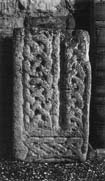Select a site alphabetically from the choices shown in the box below. Alternatively, browse sculptural examples using the Forward/Back buttons.
Chapters for this volume, along with copies of original in-text images, are available here.
Object type: Part of grave-cover
Measurements: L. 73 cm (28.7 in) W. 41 > 40 cm (16.1 > 15.7 in) D. 35 > 34 cm (13.8 > 13.4 in)
Stone type: [Ancaster Freestone, Upper Lincolnshire Limestone, Inferior Oolite Group]
Plate numbers in printed volume: Fig. 9; Ills. 90–1
Corpus volume reference: Vol 5 p. 128-129
(There may be more views or larger images available for this item. Click on the thumbnail image to view.)
A small fragment from the corner of an upright rectangular grave-marker decorated on both broad faces with similar if not identical designs. The stone has been carefully cut for reuse.
A and C (broad): The field was divided into a series of square boxes by simply incised lines. Within the two boxes on each face of the surviving fragment is placed a simple incised cross saltire. It is uncertain how the remainder of the original faces would have been decorated. The cross saltires could have formed a border along one edge of either face or alternatively could have filled the whole field.
B (narrow) and E (top): The edge of the marker, which survives on two adjacent sides, is of rectangular section and undecorated.
This stone has many of the characteristics of the mid-Kesteven group of grave-covers (Chapter V). It has the correct Ancaster stone type and the characteristic layout and style of interlace. It is one of the thirteen examples which are decorated on their original lids with a large cross surrounded by interlace (Fig. 9). But the distinctive run of loops across the top panel of this face is a detail it shares only with Colsterworth 3 (Ill. 89). Also like Colsterworth 3, the interlace surrounding the cross shape does not develop out of the cross-arm terminals. At Coleby, only one of the runs of interlace has a medial line and this represents a relatively low level of subsidiary decoration within this group of monuments. Similar exaggerated grooves between the two horizontal panels on the flank at Coleby are found at Burton Pedwardine(no. 3b, Ill. 77). None of these minor details is especially helpful for developing a meaningful internal chronology within the mid-Kesteven group. The running loop motif, however, is quite commonly met with in Yorkshire sculpture which is usually dated to the tenth century (e.g. Hawsker, Kirklevington, Leeds etc.). The mid-Kesteven cover group as a whole is dated to between the mid tenth and the early eleventh century.



